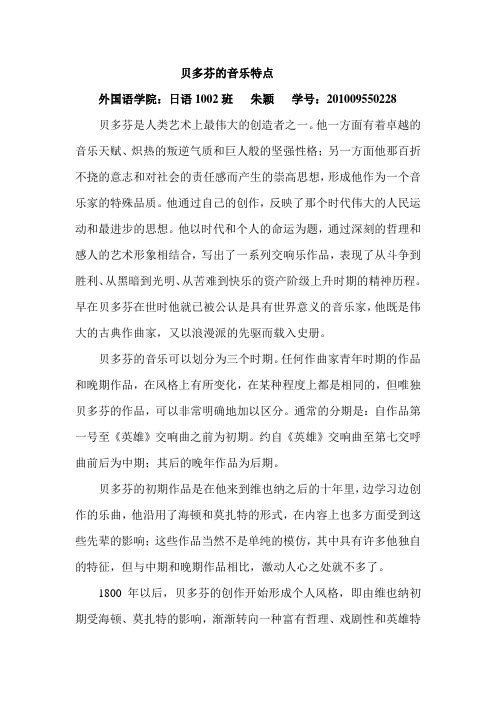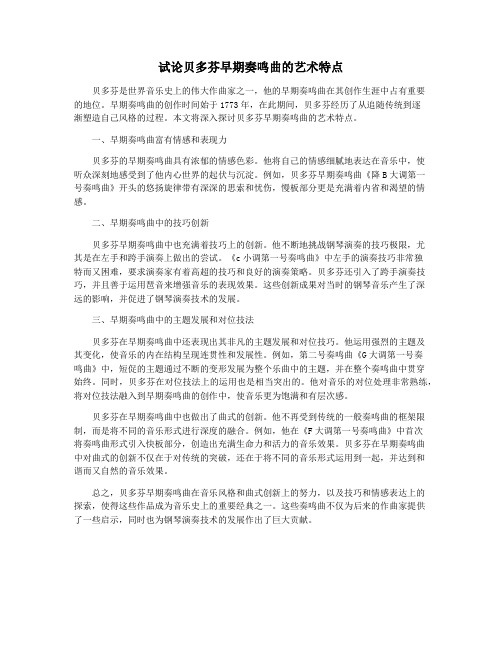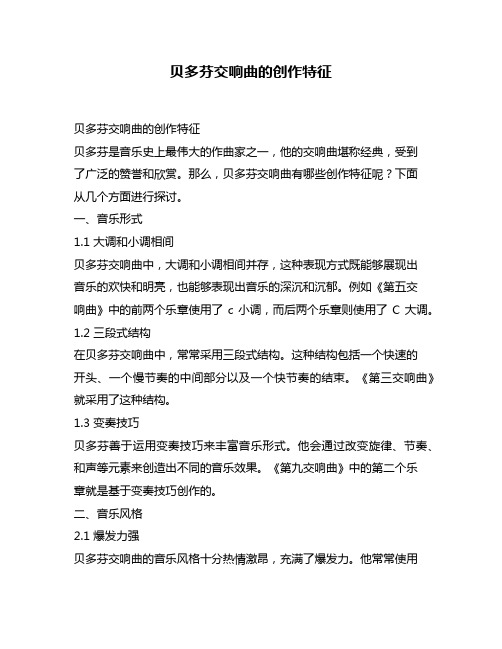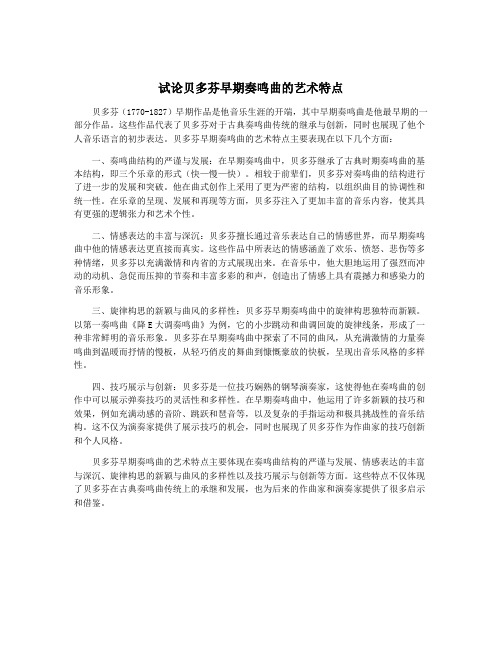贝多芬音乐特点
奏鸣曲贝多芬特点

奏鸣曲贝多芬特点
奏鸣曲是贝多芬最重要的作品类型之一,他一生中创作了32首奏鸣曲。
以下是贝多芬奏鸣曲的特点:
1. 强烈的音乐表现力:贝多芬的奏鸣曲充满了激情和表现力,他通过音乐来表达情感和思想。
2. 丰富的曲式结构:贝多芬的奏鸣曲结构复杂,通常由三个或四个乐章组成,其中包括快速的、慢速的、舞曲和终曲等。
3. 个性化的旋律和和声:贝多芬的奏鸣曲中的旋律和和声往往是非传统的,有时是突兀的和不协调的,这种风格被称为“贝多芬风格”。
4. 手指技巧的挑战:贝多芬的奏鸣曲常常要求演奏者具有高超的手指技巧,包括快速的音阶和跨度广泛的和弦。
5. 具有史诗般的气质:贝多芬的奏鸣曲常常具有史诗般的气质,它们是对自由、理性和人类尊严的赞颂,表达了贝多芬的哲学思想和信念。
贝多芬的奏鸣曲不仅是西方音乐史上的重要经典作品,更是对音乐艺术和人类文化的贡献。
- 1 -。
贝多芬的音乐特点

贝多芬的音乐特点外国语学院:日语1002班朱颖学号:201009550228贝多芬是人类艺术上最伟大的创造者之一。
他一方面有着卓越的音乐天赋、炽热的叛逆气质和巨人般的坚强性格;另一方面他那百折不挠的意志和对社会的责任感而产生的崇高思想,形成他作为一个音乐家的特殊品质。
他通过自己的创作,反映了那个时代伟大的人民运动和最进步的思想。
他以时代和个人的命运为题,通过深刻的哲理和感人的艺术形象相结合,写出了一系列交响乐作品,表现了从斗争到胜利、从黑暗到光明、从苦难到快乐的资产阶级上升时期的精神历程。
早在贝多芬在世时他就已被公认是具有世界意义的音乐家,他既是伟大的古典作曲家,又以浪漫派的先驱而载入史册。
贝多芬的音乐可以划分为三个时期。
任何作曲家青年时期的作品和晚期作品,在风格上有所变化,在某种程度上都是相同的,但唯独贝多芬的作品,可以非常明确地加以区分。
通常的分期是:自作品第一号至《英雄》交响曲之前为初期。
约自《英雄》交响曲至第七交呼曲前后为中期;其后的晚年作品为后期。
贝多芬的初期作品是在他来到维也纳之后的十年里,边学习边创作的乐曲,他沿用了海顿和莫扎特的形式,在内容上也多方面受到这些先辈的影响;这些作品当然不是单纯的模仿,其中具有许多他独自的特征,但与中期和晚期作品相比,激动人心之处就不多了。
1800年以后,贝多芬的创作开始形成个人风格,即由维也纳初期受海顿、莫扎特的影响,渐渐转向一种富有哲理、戏剧性和英雄特质的音乐思想,从而形成新的创作倾向和创作风格。
1804年贝多芬完成了《第三交响曲》(即《英雄交响曲》)的创作,这标志着贝多芬的创作道路进入了成熟阶段。
这部作品完全奠定了他创作的基本逻辑枣“通过斗争,得到胜利”,“通过艰苦,走向欢乐”。
《英雄交响曲》标志着他创作的“英雄年代”的开始。
这一时期他还创作了其它一些重要作品,包括《第十四钢琴奏鸣曲》(即《月光》,1801)、《第二十一钢琴奏鸣曲》(即《黎明》,1804)、《第二十三钢琴奏鸣曲》(即《热情》,1806)、《D大调小提琴奏鸣曲》(1806)、歌剧《菲德里奥》(1805)、《克罗采小提琴奏鸣曲》(1803)等。
浅谈贝多芬钢琴奏鸣曲的音乐风格及艺术特征

浅谈贝多芬钢琴奏鸣曲的音乐风格及艺术特征贝多芬(Ludwig van Beethoven)是世界著名的古典音乐作曲家,他的作品被视为古典音乐的经典之一。
在其众多作品中,钢琴奏鸣曲是其中的一大亮点,展现了贝多芬音乐创作的深厚功力和独特魅力。
本文将对贝多芬钢琴奏鸣曲的音乐风格及艺术特征进行深入探讨,以期更好地理解和欣赏这些具有历史意义的音乐作品。
一、音乐风格贝多芬钢琴奏鸣曲的音乐风格具有明显的古典主义和浪漫主义特征。
古典主义音乐以对称、规则和平衡为特点,贝多芬的早期钢琴奏鸣曲在这一风格基础上,呈现出清晰的结构和简洁的旋律。
如《第1号钢琴奏鸣曲》,其充满了和声的变化和对位法则的运用,展现了贝多芬艺术家的严谨和谨慎。
而随着时间的推移,贝多芬的钢琴奏鸣曲逐渐展现出浪漫主义的特征。
这一时期的作品,如《第14号《月光》》展现出了音乐情感的丰富和个性化,旋律更加细腻和优美,结构更加复杂和多变。
贝多芬通过这些作品,将古典主义和浪漫主义的特点融为一体,创造出了具有独特魅力的音乐语言。
二、艺术特征贝多芬钢琴奏鸣曲的艺术特征主要表现在以下几个方面:1. 极大的表现力贝多芬的钢琴奏鸣曲以其极大的表现力成为世人瞩目的焦点。
他通过对音乐形式和结构的重新塑造,以及对音乐情感的深刻挖掘,使得作品具有了更加丰富和深刻的内涵。
例如《第8号《悲怆》》,其富有激情和戏剧性,充分展现出了贝多芬极大的表现力和情感表达能力。
2. 独特的音乐语言贝多芬的钢琴奏鸣曲展现出了独特的音乐语言,其特点在于旋律优美、旋律变化多端和和声复杂丰富。
贝多芬充分运用了对位法、音乐分解和复合的手法,创造出了多姿多彩的音乐世界。
例如《第23号《热情》》,其曲调雄浑而深沉,音调的变化丰富多样,是贝多芬音乐风格的典范之作。
3. 强烈的个性特征贝多芬的钢琴奏鸣曲显示出了强烈的个性特征,他对音乐形式和结构的创新,以及对音乐情感的深入挖掘,使得每一部作品都具有了独特的气质和个性。
论贝多芬音乐风格的特点

的焦点 , 想 的主题 。这个 ‘ ’ 要 自我肯定 、 幻 人 需 自我 崇拜、 自我 想象 以至 自我 宣泄 , 即使 是表 达一 种对 大
自然 的亲近 感 , 是通 过 赞 美 自然 来 抒 发 自我 的渴 也
加 明显 。 者通过 调性对 比 , 表现 不 同的性格 。 两 来 主 部性 格 积极 、 情 , 热 副部主题 比较 柔和 、 暗叹 。 常见 的
越两个 时代 的“ 乐 巨人 ” 音 。贝 多芬这 个名字 与他 在
氏
贝 多芬 的音乐 特 点 , 者认 为 主要 体 现 在 以下 笔
’ 几个 方 面 :
展开部 把音 乐 的感 性材料 、音 乐 的形式 和 内容 以及
≯
有 超越 前人 的 自我 追求 。在 我欣 赏过 的所有 贝多芬 音 乐作 品 中 , 印象 比较 深刻 的是《 月光奏 鸣 曲》 这首 , 奏 鸣 曲是贝 多芬在 双 目失 明的情况 下完 成 的不 朽之
作 。《 光奏 鸣 曲》 于 1 0 年 , 时他 和朱 丽 叶 ・ 月 作 81 当
誉 , 是 继海 顿 、 他 莫扎 特 之后 最 伟 大 的欧 洲作 曲家 . 扩充 和发 展 了由海 顿 、 莫扎 特 创 立并 发 展起 来 的维 也纳古 典音 乐形 式与 风格 , 同时 。 他将 十八世 纪 的古
典 主义 与十 九世 纪 的 浪漫 主义 联 系 在一 起 , 为跨 成
发 展 的趋 势 , 这种趋 势是通 过调性 表 现 出来 的 , 呈示 部 只有 主调 和属调 的关 系。 四 、 声在作 品 中不是 第 尾 简单 的乐 思 收缩 , 而具有一 定 的展开 性质 。
浅谈贝多芬钢琴奏鸣曲的音乐风格及艺术特征

浅谈贝多芬钢琴奏鸣曲的音乐风格及艺术特征贝多芬是古典音乐史上最具代表性和影响力的作曲家之一,他的钢琴奏鸣曲集是其音乐创作的重要组成部分。
这些作品具有非常独特的音乐风格和艺术特征,反映了贝多芬的音乐思想和个性。
一、音乐风格1. 运用复杂的音乐结构贝多芬的钢琴奏鸣曲采用了复杂的音乐结构,具有较长的音乐句式和乐章。
他在音乐形式的构建上运用了各种变化和发展,从而使作品变得丰富多彩。
2. 强调音乐表现力和情感表达贝多芬的钢琴奏鸣曲强调音乐表现力和情感表达。
他善于运用音乐表现技巧,刻画人物形象和情感体验。
他的钢琴奏鸣曲在情感表达上较为深刻,刻画出了人生的苦涩和美好。
3. 以钢琴为主导乐器贝多芬的钢琴奏鸣曲以钢琴为主导乐器,整个作品的音乐思路和主题都是建立在钢琴和弹奏上的。
他通过钢琴的演奏技巧和音色变化传递了丰富的情感和意境。
二、艺术特征1. 较强的独创性和创新性贝多芬的钢琴奏鸣曲具有较强的独创性和创新性,他跳脱了传统音乐结构和旋律风格的束缚,吸收了各种新的音乐元素和技法。
2. 蕴含有对人性的思考和探究贝多芬的钢琴奏鸣曲蕴含有对人性的思考和探究。
他在音乐中表达了对于人生、爱情、艺术、自由等问题的看法和感悟。
3. 具有坚定的个性和想法贝多芬的钢琴奏鸣曲具有坚定的个性和想法。
他的作品反映了他独特的思维方式和艺术观点,表现了他对于美的追求和对于人生意义的探索。
总之,贝多芬的钢琴奏鸣曲是他音乐创作的代表作之一,展现了他丰富的音乐思想和卓越的创作才华,对于古典音乐的发展和演进具有深刻的影响。
贝多芬的音乐奇迹

贝多芬的音乐奇迹贝多芬(Ludwig van Beethoven)是一位伟大的音乐家,被誉为音乐史上最重要的作曲家之一。
他的音乐作品以其深情和情感表达而著称,对音乐世界产生了深远的影响。
本文将探讨贝多芬音乐的奇迹所在,以及他在音乐领域的重要贡献。
一、贝多芬音乐的独特风格贝多芬的音乐作品充满激情和力量,它们展示了他与众不同的创作风格。
他的作品结构严谨,富有戏剧性和冲突性。
贝多芬的音乐常常带有复杂的节奏和和声,其旋律也非常独特。
他敢于挑战音乐传统,引入新的创作方法和音乐形式,给人们带来了耳目一新的感受。
二、贝多芬音乐中的情感表达贝多芬的音乐作品深情而充满情感,每一曲调都能打动人心。
他通过音乐表达了自己内心深处的情感和思想。
其中著名的《命运交响曲》、《第九交响曲》和《月光奏鸣曲》等作品,表达了希望、坚韧、爱与和平的理念,成为人们心中的经典。
三、贝多芬与音乐创新贝多芬对音乐创新作出了重要的贡献。
他推动了音乐的发展,尤其在交响乐和钢琴音乐方面取得了巨大成功。
他将音乐中心从庄严的教堂音乐转向了个人情感的表达,通过创造性的和声和旋律,开创了浪漫时期音乐的新篇章。
四、贝多芬的聋病贝多芬的音乐奇迹更加令人震惊的是他在聋病的困扰下创作的作品。
虽然他在晚年几乎完全失去了听力,但他依然能够创作出宏伟而深情的音乐。
贝多芬的聋病加深了他对内心情感的关注,使他的音乐更加富有深度和灵性。
五、贝多芬永恒的遗产贝多芬的音乐奇迹不仅体现在他的创作中,更是通过他的作品影响了几个世纪的音乐发展。
他的音乐激励了无数音乐家,包括著名的作曲家如勃拉姆斯、马勒和柴可夫斯基等,他们的音乐都受到了贝多芬的影响。
六、贝多芬的音乐奇迹启发我们贝多芬的音乐奇迹不仅是他作曲才华的体现,更是他对人类情感和人性的思考。
我们可以从中得到启发,培养自己的思考和创作能力,用音乐表达自己的情感和思想。
结论:贝多芬的音乐奇迹激励了几代人,他的音乐作品不仅仅是美的享受,更是给人们带来情感上的触动和人生的启示。
贝多芬论述题

贝多芬论述题1) 贝多芬的音乐风格与特点:贝多芬是浪漫主义时期最杰出的作曲家之一,他的音乐风格充满了激情、力量和情感。
他的作品具有复杂的音乐结构、丰富的旋律线条和独特的和声处理。
贝多芬的音乐作品表达了人类的苦难、希望和自由的追求,常常运用对比和冲突的手法来表达情感。
他的音乐具有很高的技术要求和演奏难度,体现了作曲家对音乐表达力和表演技巧的追求。
2) 贝多芬创作的音乐类型和作品:贝多芬创作了大量的音乐作品,涵盖了交响乐、室内乐、器乐曲、声乐曲等多种类型。
其中最著名的作品包括九部交响曲、五部钢琴协奏曲、三部钢琴奏鸣曲、三部小提琴奏鸣曲等。
他也创作了一些宗教音乐作品,如《弥撒曲》。
贝多芬的作品经常被视为音乐史上的经典之作,对后世的作曲家产生了深远的影响。
3) 贝多芬的创作风格演变:贝多芬的创作风格在他的一生中有明显的演变。
他早期的作品受到了古典主义作曲家如海顿和莫扎特的影响,但已经显示出他自己独特的风格。
然而,他中期的作品更加个人化和丰富,特别是在他的浪漫主义时期创作的作品中,他运用了更大胆的和声和旋律创作手法。
在他的晚年,由于聋音的加重,他的创作更加内省和沉思,展现了对生命、死亡和人类命运的深刻思考。
4) 贝多芬的音乐对后世的影响:贝多芬的音乐对后世的音乐家和作曲家产生了深远的影响。
他的音乐风格和创作手法成为了浪漫主义音乐的重要基础,许多后来的作曲家通过借鉴贝多芬的创作理念来发展自己的音乐风格。
他的作曲风格对维也纳学派和德国音乐传统的发展产生了重要影响,也对整个西方音乐产生了深远的影响。
贝多芬的音乐作品被广泛演奏和欣赏,并被视为音乐史上最伟大的作曲家之一。
谈贝多芬钢琴奏鸣曲的创作特点

谈贝多芬钢琴奏鸣曲的创作特点
贝多芬钢琴奏鸣曲的创作特点体现在以下几个方面:
1. 创新性:贝多芬在钢琴奏鸣曲的创作中展现出了极高的创新性。
他推翻了传统的形式和结构,将其扩展和发展成更加丰富和深入的表达方式。
他在曲式、主题发展和和声技巧方面进行了大胆的尝试,为后来的作曲家树立了典范。
2. 情感表达:贝多芬的钢琴奏鸣曲以其强烈的情感表达而闻名。
他能够通过琴键传达出激情、愤怒、悲伤、欢乐等各种情感。
他的作品常常具有情感的变化和冲突,从柔情到激昂,从抒情到激动,体现了生活的多样性和复杂性。
3. 技术要求:贝多芬的钢琴奏鸣曲对演奏者的技术要求很高。
他创作了许多充满挑战的技巧和艰巨的速度要求的乐曲,极大地拓展了钢琴的技术和演奏范围。
这些曲目要求演奏者具备出色的手指技巧、音乐感知力和表演能力。
4. 音乐形式:贝多芬的钢琴奏鸣曲大多采用了多个乐章的形式,通常由一个快速、精力充沛的第一乐章开始,接着是一个抒情的慢板,然后是一个活泼的小曲或者舞曲,最后以宏伟的第四乐章结束。
这种形式结构的设计使得贝多芬的钢琴奏鸣曲更加丰富和完整。
总体而言,贝多芬的钢琴奏鸣曲具有其独特的创作风格和特点,体现了他对音乐形式、情感表达和艺术技巧的创新和探索。
这
些作品不仅仅是为了展示技巧和音乐效果,更是通过音乐来传递情感和思想,使听众可以在其中体验到丰富的内心世界。
浅谈贝多芬钢琴奏鸣曲的音乐风格及艺术特征

浅谈贝多芬钢琴奏鸣曲的音乐风格及艺术特征贝多芬(Ludwig van Beethoven)是浪漫主义时期最重要的作曲家之一,他的钢琴奏鸣曲作品堪称经典。
贝多芬的钢琴奏鸣曲音乐风格独特,作品充满了个性、激情和创新,展现了他作为作曲家的独特艺术特征。
贝多芬的钢琴奏鸣曲音乐风格以其独特的个性和丰富的情感表达而著称。
贝多芬常常在作品中表达他内心深处的情感和心境,带给听众一种强烈的感受。
他的作品不再追求简单的表面美感,而是追求真实、深刻的情感体验。
贝多芬的“月光奏鸣曲”(Piano Sonata No. 14 in C-sharp minor, op. 27, No. 2)被誉为他最著名的作品之一,这首奏鸣曲中的第一乐章以其梦幻般的旋律和独特的和声结构而闻名于世,充满了浪漫主义情感和内心痛苦的表达。
贝多芬的钢琴奏鸣曲具有强大的创新精神和技巧上的挑战性。
贝多芬在他的钢琴奏鸣曲中不断突破传统形式的束缚,创造出了独特而复杂的结构。
他引入了自由奏鸣曲式(free sonata form),在曲式结构上进行了创新。
他还通过大胆的和声和技巧上的挑战来展示他对钢琴音乐的独到见解。
他的钢琴奏鸣曲《热情》(Piano Sonata No. 23 in F minor, Op. 57)中的第三乐章以其复杂的技巧和充满激情的音乐表达而闻名。
贝多芬的钢琴奏鸣曲的音乐语言非常丰富多样。
他的作品中融合了古典和浪漫主义的元素,展现了他对音乐语言的独特理解。
它们的旋律线索清晰,变化多样,表达力强烈。
贝多芬还常常使用对位法和和声振奋人心的对位法和和声技巧。
他还利用丰富的音色和细腻的音乐品味来创造出令人难以忘怀的钢琴音乐。
贝多芬的钢琴奏鸣曲展现了他对人类情感和命运的关注。
贝多芬的音乐常常表达对人类命运的思考和对人性的关怀,他的作品中常常融入力量和希望的主题。
他在音乐中通过独特的和声、旋律和节奏表达出我们共同的人类经验和情感,使得他的音乐具有普遍性。
贝多芬奏鸣曲风格特点

贝多芬奏鸣曲风格特点贝多芬是古典音乐史上最伟大的作曲家之一,他的奏鸣曲堪称经典。
贝多芬的奏鸣曲风格特点独具个性,犹如一次音乐的冒险之旅。
本文将介绍贝多芬奏鸣曲的几个主要特点,使读者能更深入地了解贝多芬的音乐世界。
首先,贝多芬奏鸣曲的奏鸣形式是其作品的骨架。
奏鸣形式由三个部分组成:第一部分为主题的交替发展,第二部分为中间部分,又称为副主题,第三部分为回归主题。
贝多芬巧妙地运用奏鸣形式来展示他的音乐构思,给人一种张力十足的感觉。
其次,贝多芬奏鸣曲的动态变化丰富多样。
在他的奏鸣曲中,经常出现急速的音乐旋律,给人一种冲击力十足的感觉。
贝多芬擅长运用演奏技巧来表现音乐的表情和情感,使人能够深入感受到他的内心世界。
此外,贝多芬奏鸣曲的旋律充满情感。
贝多芬笔下的旋律常常充满激情和内省,让人既有共鸣又能引发人们的思考。
他的旋律线条优美而富有个性,给人一种深沉而又激昂的感觉。
贝多芬奏鸣曲还以其丰富的和声和对位技巧著称。
贝多芬的和声常常让人感到意想不到,既有新颖之处又能保持音乐的流畅性。
他善于运用对位手法来创造丰富的音乐纹理,使听者能够在音乐中感受到层次感和立体感。
最后,贝多芬的奏鸣曲不局限于传统的形式和规则,他敢于突破音乐界限,创造出勃勃生机的音乐世界。
他以其独特的创作理念和创新精神,给后世作曲家们提供了重要的启示和影响。
总之,贝多芬奏鸣曲的风格特点独一无二,犹如一场音乐冒险。
他的作品充满了张力、激情和思考,既表达了他个人的情感,又唤醒了人们对音乐的热爱和渴望。
贝多芬的音乐是人类文化宝库中的瑰宝,不仅是音乐史上的经典之作,也是每个音乐爱好者必须一探究竟的宝藏。
让我们一起潜入贝多芬的音乐世界,在那里找到心灵的共振和创作的灵感。
贝多芬钢琴奏鸣曲的音乐风格及艺术特征探讨

贝多芬钢琴奏鸣曲的音乐风格及艺术特征探讨
贝多芬是音乐史上伟大的作曲家之一,他的钢琴奏鸣曲使他成为了钢琴音乐的重要代表人物之一。
本文将探讨贝多芬钢琴奏鸣曲的音乐风格及艺术特征。
一、音乐风格
1.早期作品:早期贝多芬钢琴奏鸣曲的音乐风格源于莫扎特和海顿,其中主题轮回的形式和即兴元素被广泛使用。
2.中期作品:中期作品的节奏变化明显,时而快速而缓慢,节拍对比强烈。
贝多芬开始使用更加宽广、史诗般的音乐结构,展现出明显的感情和热情。
同时,他开始运用变奏形式,多次循环主题,让主题在音乐中被发掘和展现。
3.后期作品:后期钢琴奏鸣曲的音乐风格越来越离经叛道,这得益于他对和声的解构和亢奋情感的表现。
大量的三部曲结构被用于贝多芬的钢琴作品,这是一种创新的形式,展现了贝多芬对音乐结构的深刻理解。
二、艺术特征
1.动情的风格:贝多芬的钢琴奏鸣曲充满了情感,他鲜明而有力地表达了各种情绪:伤感、激情、哀愁、欢乐等。
2.创新的节奏:贝多芬的钢琴奏鸣曲节奏灵活而多变,在音乐中呈现出连贯的和谐结构,同时保持着旺盛的动力和感情。
3.宏大的音乐结构:贝多芬的钢琴奏鸣曲在音乐结构上经常使用三部曲形式,使其音乐性和完整性更为完美。
4.用音乐展示情感:贝多芬钢琴奏鸣曲注重情感的表达,他善于将自己的情感转化为音乐,让人们感受到音乐的感染力和表现力。
总之,贝多芬的钢琴奏鸣曲是钢琴音乐中不可忽视的一部分,其音乐风格和艺术特征对整个音乐史产生了深远的影响,是音乐界的经典作品。
简述贝多芬的创作及艺术成就

简述贝多芬的创作及艺术成就贝多芬(Ludwig van Beethoven)是德国著名的古典音乐作曲家和钢琴家,他的创作和艺术成就对音乐界产生了深远的影响。
本文将从贝多芬的创作特点、音乐风格以及他对音乐的艺术贡献等方面进行简述,以展示他在音乐领域的卓越成就。
贝多芬的创作特点体现在他对音乐形式和结构的创新以及情感表达的深度。
他的作品大多具有严谨的结构和丰富的情感内涵,充满了力量和激情。
他的创作形式包括交响曲、钢琴协奏曲、室内乐和钢琴独奏曲等,其中最著名的作品有《命运交响曲》、《月光奏鸣曲》等。
贝多芬的音乐表达了人类内心深处的情感和思考,既有激昂激情的乐章,又有悲伤忧郁的旋律,展现了丰富的音乐世界。
贝多芬的音乐风格独树一帜,他在音乐创作上的突破使他成为古典音乐的先驱。
他将古典时期的音乐形式与浪漫主义的情感表达相结合,创造了独特的音乐语言。
他的音乐作品充满了对生命的热爱和对人性的探索,既有宏大壮丽的气势,又有细腻柔情的表达。
他的音乐风格影响了后来的作曲家,如勃拉姆斯、舒曼等。
贝多芬的艺术成就不仅体现在他的创作上,还表现在他对音乐的演奏和指导上。
他是一位卓越的钢琴家,他的钢琴演奏技巧和表演风格使他成为当时最受欢迎的音乐家之一。
他的演奏具有独特的个性和强烈的表达力,深受观众和音乐界的赞赏。
此外,贝多芬还对音乐教育有着重要的贡献。
他的学生中有许多后来成为了杰出的音乐家,如卡尔·马利亚·冯·韦伯、弗朗茨·什泼尔等。
他的指导和影响使他们成为了音乐界的佼佼者,延续了贝多芬音乐传统的发展。
贝多芬的艺术成就不仅在他一生的创作中得到了体现,也在他逐渐失去听力的困境中展现出来。
贝多芬在晚年失去了听力,但他仍然坚持创作,用心灵的力量创造了一系列具有深度和感染力的作品。
他的晚期作品如《第九交响曲》和《贝多芬弦乐四重奏》被认为是音乐史上的巅峰之作,展现了他对音乐的无尽追求和对人类精神的崇高理想。
浅谈贝多芬钢琴奏鸣曲的音乐风格及艺术特征

浅谈贝多芬钢琴奏鸣曲的音乐风格及艺术特征贝多芬是古典音乐史上最重要的作曲家之一,他的钢琴奏鸣曲是其创作的重要组成部分。
贝多芬一生创作了32首钢琴奏鸣曲,展示了他的音乐才华和独特的艺术风格。
下面我来谈谈贝多芬钢琴奏鸣曲的音乐风格及艺术特征。
贝多芬的钢琴奏鸣曲的音乐风格可以分为早期、中期和晚期三个阶段。
早期的钢琴奏鸣曲风格还受到了古典时期的影响,音乐结构相对简洁明快,旋律流畅易懂,情感表达简洁明确。
贝多芬的早期钢琴奏鸣曲中,例如《D大调第三号奏鸣曲》和《降A大调第十七号奏鸣曲》等作品,运用了经典的奏鸣曲形式,音乐清晰、明快。
中期的钢琴奏鸣曲是贝多芬作品的巅峰时期,他在音乐形式、结构和表现手法上进行了创新。
贝多芬的中期钢琴奏鸣曲中,例如《月光奏鸣曲》和《热情奏鸣曲》等作品,具有宏大的音乐构思和强烈的表现力,音乐冲击力强,旋律表现痛苦、挣扎和矛盾的情感。
首先是音乐表现的力度和矛盾性。
贝多芬的钢琴奏鸣曲具有强烈的音乐动力和冲击力,常常在音乐中表现出对立的情感,如忧郁与欢快、温柔与暴力、平静与激情的对比,这种音乐表达的矛盾性是贝多芬音乐的一大特点。
其次是对音乐形式的创新。
贝多芬对传统的奏鸣曲形式进行了创新,使其由原本的结构简洁明快转变为结构丰富、复杂变化的音乐形式。
他在曲式的布局和处理上常常展现出巧妙的构思和创意,以独立的和自由的方式发展音乐表达的内涵。
再次是音乐主题的发展和变化。
贝多芬的钢琴奏鸣曲中,经常出现富有个性化的主题,这些主题会在整个曲目中进行发展和变化。
他通过对主题的多次重复和运用,使整个作品充满了统一性和连贯性,同时又富于变化和新意。
最后是技巧和演奏的要求。
贝多芬的钢琴奏鸣曲对钢琴技巧和演奏要求非常高,具有很高的技巧性和表现力,演奏难度很大。
演奏贝多芬的钢琴奏鸣曲需要具备良好的音乐素养和精湛的钢琴技巧,同时还要能够准确地表达贝多芬所追求的音乐情感和内涵。
贝多芬的钢琴奏鸣曲具有丰富多样的音乐风格和独特的艺术特征。
简述贝多芬的创作特点

贝多芬的创作风格有什么特点?
与海顿、莫扎特两位前辈相比,贝多芬的创作在音乐风格上有相似和不同之处,更有继承与发展的关系。
贝多芬的创作不但追求情绪对比,而且其作品的情绪对比也相当尖锐,他的音乐具有高度的紧张度和兴奋度,往往形成巨大的高潮。
在同一个乐章或同一个作品中,可能既有暴风雨式的力量强大的音乐,又有温柔典雅、幽默抒情的情绪。
贝多芬作品的音域和力度都比他的前人扩大了许多。
在体裁上,贝多芬使交响曲成为体现作曲家最重要乐思的体裁。
他的交响曲超出了贵族沙龙的容纳范围而要求为音乐厅听众演奏(虽然他本人写作时并不一定这样认识)。
他的交响套曲突出了对比和扩展的原则。
其主题与主题之间、乐章与乐章之间都讲求调性、音调和性格上的对比和扩展。
他的主题大都提供了扩充和展开乐思的条件和可能,而他的乐章的长度又因主题的展开、展开部及尾声的扩充而大大扩展。
其尾声已从一般形式上的结尾扩展为与作品内容和逻辑相符的总结,有时甚至实际上成了“第二展开部“(如弦乐四重奏作品59)。
他的奏鸣交响套曲把宫廷舞蹈性的小步舞曲乐章变成谐谑曲,使其更富节奏性和动力性。
他的慢乐章往往具有深刻的思想深度和感情的升华。
他常常用高潮性的、胜利凯旋的音乐作为终曲乐章,而且似乎全曲都是有意识地在为建构这个终曲而作酝酿和准备。
他把终曲乐章扩大到与第一乐章规模相等的长度并与前面几个乐章保持密切的内在联系。
此外,贝多芬是第一个将动机贯穿乐曲始终的作曲家。
试论贝多芬早期奏鸣曲的艺术特点

试论贝多芬早期奏鸣曲的艺术特点贝多芬是世界音乐史上的伟大作曲家之一,他的早期奏鸣曲在其创作生涯中占有重要的地位。
早期奏鸣曲的创作时间始于1773年,在此期间,贝多芬经历了从追随传统到逐渐塑造自己风格的过程。
本文将深入探讨贝多芬早期奏鸣曲的艺术特点。
一、早期奏鸣曲富有情感和表现力贝多芬的早期奏鸣曲具有浓郁的情感色彩。
他将自己的情感细腻地表达在音乐中,使听众深刻地感受到了他内心世界的起伏与沉淀。
例如,贝多芬早期奏鸣曲《降B大调第一号奏鸣曲》开头的悠扬旋律带有深深的思索和忧伤,慢板部分更是充满着内省和渴望的情感。
二、早期奏鸣曲中的技巧创新贝多芬早期奏鸣曲中也充满着技巧上的创新。
他不断地挑战钢琴演奏的技巧极限,尤其是在左手和跨手演奏上做出的尝试。
《c小调第一号奏鸣曲》中左手的演奏技巧非常独特而又困难,要求演奏家有着高超的技巧和良好的演奏策略。
贝多芬还引入了跨手演奏技巧,并且善于运用琶音来增强音乐的表现效果。
这些创新成果对当时的钢琴音乐产生了深远的影响,并促进了钢琴演奏技术的发展。
三、早期奏鸣曲中的主题发展和对位技法贝多芬在早期奏鸣曲中还表现出其非凡的主题发展和对位技巧。
他运用强烈的主题及其变化,使音乐的内在结构呈现连贯性和发展性。
例如,第二号奏鸣曲《G大调第一号奏鸣曲》中,短促的主题通过不断的变形发展为整个乐曲中的主题,并在整个奏鸣曲中贯穿始终。
同时,贝多芬在对位技法上的运用也是相当突出的。
他对音乐的对位处理非常熟练,将对位技法融入到早期奏鸣曲的创作中,使音乐更为饱满和有层次感。
贝多芬在早期奏鸣曲中也做出了曲式的创新。
他不再受到传统的一般奏鸣曲的框架限制,而是将不同的音乐形式进行深度的融合。
例如,他在《F大调第一号奏鸣曲》中首次将奏鸣曲形式引入快板部分,创造出充满生命力和活力的音乐效果。
贝多芬在早期奏鸣曲中对曲式的创新不仅在于对传统的突破,还在于将不同的音乐形式运用到一起,并达到和谐而又自然的音乐效果。
贝多芬交响曲的创作特征

贝多芬交响曲的创作特征贝多芬交响曲的创作特征贝多芬是音乐史上最伟大的作曲家之一,他的交响曲堪称经典,受到了广泛的赞誉和欣赏。
那么,贝多芬交响曲有哪些创作特征呢?下面从几个方面进行探讨。
一、音乐形式1.1 大调和小调相间贝多芬交响曲中,大调和小调相间并存,这种表现方式既能够展现出音乐的欢快和明亮,也能够表现出音乐的深沉和沉郁。
例如《第五交响曲》中的前两个乐章使用了c小调,而后两个乐章则使用了C大调。
1.2 三段式结构在贝多芬交响曲中,常常采用三段式结构。
这种结构包括一个快速的开头、一个慢节奏的中间部分以及一个快节奏的结束。
《第三交响曲》就采用了这种结构。
1.3 变奏技巧贝多芬善于运用变奏技巧来丰富音乐形式。
他会通过改变旋律、节奏、和声等元素来创造出不同的音乐效果。
《第九交响曲》中的第二个乐章就是基于变奏技巧创作的。
二、音乐风格2.1 爆发力强贝多芬交响曲的音乐风格十分热情激昂,充满了爆发力。
他常常使用强烈的节奏和动态来表达自己内心深处的情感,让人们感受到他内心深处的激情。
2.2 情感丰富贝多芬交响曲中,情感丰富多样。
他可以通过音乐表达出欢快、忧伤、愤怒、宁静等不同的情感,让人们在听到他的音乐时,仿佛能够看到他内心深处所经历的各种情感。
2.3 音色变化贝多芬善于运用不同的音色来表达不同的情感。
在《第五交响曲》中,他使用了低沉而沉重的大提琴和低音提琴来表现出悲伤和沮丧。
三、旋律和节奏3.1 旋律优美贝多芬交响曲中的旋律优美动听,常常让人们感到心旷神怡。
他的旋律多样化,有时激情洋溢,有时深沉凝重,但都能够让人们感受到他内心深处所经历的情感。
3.2 节奏强烈贝多芬交响曲的节奏强烈而有力,充满了活力和生命力。
他运用不同的节奏元素来创造出丰富多彩的音乐效果,让人们在听到他的音乐时仿佛能够感受到生命的脉搏。
四、结语贝多芬交响曲是音乐史上最为经典和优美的作品之一。
他通过丰富多彩的音乐形式、优美动听的旋律、强烈有力的节奏以及丰富多样的情感表达方式,创造出了一种独特而又无与伦比的音乐风格。
举作品实例说明贝多芬交响曲的创作特征

举作品实例说明贝多芬交响曲的创作特征
贝多芬交响曲是古典音乐中最重要的作品之一,具有许多独特的创作特征。
以下是一些贝多芬交响曲的创作特征的例子:
1. 强烈的个人表达:贝多芬的交响曲反映了他的个人情感和思想。
他将音乐作为一种表达自己内心世界的方式,并通过交响曲传达他的感情和观点。
2. 独特的节奏和节拍:贝多芬的交响曲以其坚定的节奏和复杂的节拍著称。
他经常使用不同的节拍和变化的节奏来创造紧张和充满活力的音乐。
3. 动态和音色的变化:贝多芬善于运用不同的动态和音色来表达情感。
他经常在作品中突然改变音乐的音量和音色,从而创造出戏剧性的效果。
4. 主题的发展:贝多芬的交响曲以其丰富的主题和主题的发展而闻名。
他善于将一个简单的主题发展成一个复杂、丰富的音乐段落,并通过不同的演奏手段和变奏来展示其多样的可能性。
5. 创新的结构和形式:贝多芬对乐曲结构和形式的创新对后来的作曲家产生了深远的影响。
他经常在交响曲中使用自由的形式,将不同的乐曲部分结合在一起,给音乐增加了戏剧性和连贯性。
6. 深思熟虑的构思:贝多芬在创作交响曲时经常进行深思熟虑的构思。
他花费大量的时间和精力来完善音乐的结构、旋律和
和声,以确保作品达到他所追求的理想境界。
以上只是一些贝多芬交响曲创作特征的例子,贝多芬的交响曲作品有着更为丰富和复杂的特点,展示了他作为作曲家的天赋和创造力。
试论贝多芬早期奏鸣曲的艺术特点

试论贝多芬早期奏鸣曲的艺术特点贝多芬(1770-1827)早期作品是他音乐生涯的开端,其中早期奏鸣曲是他最早期的一部分作品。
这些作品代表了贝多芬对于古典奏鸣曲传统的继承与创新,同时也展现了他个人音乐语言的初步表达。
贝多芬早期奏鸣曲的艺术特点主要表现在以下几个方面:一、奏鸣曲结构的严谨与发展:在早期奏鸣曲中,贝多芬继承了古典时期奏鸣曲的基本结构,即三个乐章的形式(快—慢—快)。
相较于前辈们,贝多芬对奏鸣曲的结构进行了进一步的发展和突破。
他在曲式创作上采用了更为严密的结构,以组织曲目的协调性和统一性。
在乐章的呈现、发展和再现等方面,贝多芬注入了更加丰富的音乐内容,使其具有更强的逻辑张力和艺术个性。
二、情感表达的丰富与深沉:贝多芬擅长通过音乐表达自己的情感世界,而早期奏鸣曲中他的情感表达更直接而真实。
这些作品中所表达的情感涵盖了欢乐、愤怒、悲伤等多种情绪,贝多芬以充满激情和内省的方式展现出来。
在音乐中,他大胆地运用了强烈而冲动的动机、急促而压抑的节奏和丰富多彩的和声,创造出了情感上具有震撼力和感染力的音乐形象。
三、旋律构思的新颖与曲风的多样性:贝多芬早期奏鸣曲中的旋律构思独特而新颖。
以第一奏鸣曲《降E大调奏鸣曲》为例,它的小步跳动和曲调回旋的旋律线条,形成了一种非常鲜明的音乐形象。
贝多芬在早期奏鸣曲中探索了不同的曲风,从充满激情的力量奏鸣曲到温暖而抒情的慢板,从轻巧俏皮的舞曲到慷慨豪放的快板,呈现出音乐风格的多样性。
四、技巧展示与创新:贝多芬是一位技巧娴熟的钢琴演奏家,这使得他在奏鸣曲的创作中可以展示弹奏技巧的灵活性和多样性。
在早期奏鸣曲中,他运用了许多新颖的技巧和效果,例如充满动感的音阶、跳跃和琶音等,以及复杂的手指运动和极具挑战性的音乐结构。
这不仅为演奏家提供了展示技巧的机会,同时也展现了贝多芬作为作曲家的技巧创新和个人风格。
贝多芬早期奏鸣曲的艺术特点主要体现在奏鸣曲结构的严谨与发展、情感表达的丰富与深沉、旋律构思的新颖与曲风的多样性以及技巧展示与创新等方面。
- 1、下载文档前请自行甄别文档内容的完整性,平台不提供额外的编辑、内容补充、找答案等附加服务。
- 2、"仅部分预览"的文档,不可在线预览部分如存在完整性等问题,可反馈申请退款(可完整预览的文档不适用该条件!)。
- 3、如文档侵犯您的权益,请联系客服反馈,我们会尽快为您处理(人工客服工作时间:9:00-18:30)。
Beethoven is viewed as a transitional figure between the Classical and Romantic eras of musical history. Above all, his works distinguish themselves from those of any prior composer through his creation of large, extended architectonic structures characterized by the extensive development of musical material, themes, and motifs, usually by means of "modulation", that is, a change in the feeling of the home key, through a variety of keys or harmonic regions. Although Haydn's later works often showed a greater fluidity between distant keys, Beethoven's innovation was the ability to rapidly establish a solidity in juxtaposing different keys and unexpected notes to join them. This expanded harmonic realm creates a sense of a vast musical and experiential space through which the music moves, and the development of musical material creates a sense of unfolding drama in this space. In this way Beethoven's music parallels the simultaneous development of the novel in literature, a literary form focused on the life drama and development of one or more individuals through complex life circumstances, and of contemporaneous German idealism's philosophical notion of self, mind, or spirit that unfolds through a complex process of contradictions and tensions between the subjective and objective until a resolution or synthesis occurs in which all of these contradictions and developmental phases have been resolved or encompassed in a higher unity.Beethoven continued to expand the "development" section of works, extending a trend in the works of Haydn and Mozart, who had dramatically expanded both the length and substance of instrumental music. As Beethoven's major immediate predecessors and influences, he looked to their harmonic and formal models for his own works. However, both Mozart and Haydn placed the great weight of a musical movement in the statement of ideas called the exposition, for Beethoven the development section of a sonata form became the heart of the work. Beethoven was able to do this by making the development section not merely longer, but also more structured. The very long development section of the Eroica Symphony, for example, is divided into four roughly equal sections, making it, in effect, a sonata form within a sonata form. The first movement alone of this symphony is as long as an entire typical Italian-style Mozart symphony from the 1770s. His focus on the development would, like others of his innovations, set a trend that later composers would follow.Although Beethoven wrote many beautiful and lyrical melodies, another radical innovation of his music, compared especially to that of Mozart and Haydn, is his extensive use of forceful, marked, and even stark rhythmic patterns throughout his compositions and, in particular, in his themes and motifs, some of which are primarily rhythmic rather than melodic. Some of his most famous themes, such as those of the first movements of the Third, Fifth, and Ninth symphonies, are primarily non-melodic rhythmic figures consisting of notes of a single chord, and the themes of the last movements of the Third and Seventh symphonies could more accurately be described as rhythms rather than as melodies. This use of rhythm was particularly well suited to the primacy of development in Beethoven's music, since a single rhythmic pattern can more easily than a melody be taken through a succession of different, even remote, keys and harmonic regions while retaining and conveying an underlying unity. This allowed him to combine different features of his themes in a wide variety of ways, extending the techniques of Haydn in development (see Sonata Form).He also continued another trend - towards larger orchestras - that went on until the first decade of the 20th century, and moved the center of the sound downwards in the orchestra, to the violas and the lower register of the violins and cellos, giving his music a heavier and darker feel than Haydn or Mozart. Gustav Mahler modified the orchestration of some of Beethoven's music --most notably the 3d and 9th symphonies -- with the idea of more accurately expressing Beethoven's intent in an orchestra that had grown so much larger than the one Beethoven used: for example, doubling woodwind parts to compensate for the fact that a modern orchestra has so many more strings than Beethoven's orchestra did. Needless to say, these efforts remain controversial.In his Fifth Symphony Beethoven introduced a striking motif, drawn from a late Haydn symphony, in the very opening bar, which he echoed in various forms in all four movements of the symphony. This is the first important occurrence of cyclic form.He was also fond of making usual what had previously been unusual: in the Fifth Symphony, instead of using a stately minuet, as had been the norm for the "dance" movement of a four-movement work, he created a dark march, which he used as the third movement and ran into the fourth without interruption. While one can point to previous works which had one or more of these individual features, his music, combined with the use of operatic scoring that he learned from Mehul and Cherubini, created a work which was altogether novel in effect - too novel, in fact, for some critics of the time. On the other hand, his contemporary Spohr found the finale "too baroque", though he praised the second movement as being in "good Romantic style". His Ninth Symphony included a chorus and solo voices in the 4th movement for the first time, and made extensive use of fugues, which were generally considered to be a different form of music, and again unusual in symphonies.He wrote one opera, Fidelio. It has been said that he wrote beautiful vocal music without regard for the limitations of human singers, treating the voice as if it were a symphonic instrument - even though his conversation books note his desire to make his music singable and include references that indicate that he had remembered his father's singing lessons.Beethoven's development and works are typically divided into three periods: an early period in which his works show especially the influence of Mozart and Haydn; a middle, mature period in which he developed his distinctive individual style, sometimes characterized as "heroic"; and a late period, in which he wrote works of a highly evolved, individuated, sometimes fragmented and unorthodox style sometimes characterized as "transcendent" and "sublime", where he tried to combine the baroque ideas of Handel and Bach with his icons Mozart and Haydn. In his late years he called Handel "my grand master".In contrast to Mozart, he labored heavily over his work, leaving intermediate drafts that provide considerable insight into his creative process. Early drafts of his Ninth Symphony used rough vertical marks on the score in place of actual notes, to indicate the structure he had in mind for the melody. Studies of his sketch books show the working out of dozens of variations on a particular theme, changing themes to fit with an overall structure that evolved over time, and extensive sketching of counter-melodies.。
